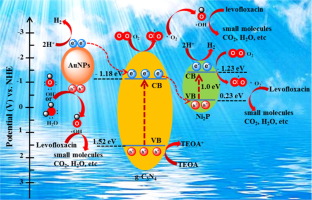当前位置:
X-MOL 学术
›
Appl. Surf. Sci.
›
论文详情
Our official English website, www.x-mol.net, welcomes your
feedback! (Note: you will need to create a separate account there.)
Remarkably enhanced visible-light photocatalytic hydrogen evolution and antibiotic degradation over g-C3N4 nanosheets decorated by using nickel phosphide and gold nanoparticles as cocatalysts
Applied Surface Science ( IF 6.3 ) Pub Date : 2020-07-01 , DOI: 10.1016/j.apsusc.2020.146187 Y.Q. He , Fangling Zhang , Bei Ma , Na Xu , Lucas Binnah Junior , Binghua Yao , Qian Yang , Dongjie Liu , Zhanying Ma
Applied Surface Science ( IF 6.3 ) Pub Date : 2020-07-01 , DOI: 10.1016/j.apsusc.2020.146187 Y.Q. He , Fangling Zhang , Bei Ma , Na Xu , Lucas Binnah Junior , Binghua Yao , Qian Yang , Dongjie Liu , Zhanying Ma

|
Abstract In this study, a highly efficient ternary 6.7%Au/Ni2P/g-C3N4 nanocomposite is rationally fabricated through a two-step hydrothermal followed by green photoreduction strategy. The XPS analysis, SEM and HRTEM images reveal that Ni2P and good nanoparticles (AuNPs) are successfully loaded onto the surface of g-C3N4 and heterojunction formed among them. The optimized 6.7%Au/0.5%Ni2P/g-C3N4 demonstrates the highest photocatalytic efficiency towards decomposition of levofloxacin hydrochloride with 88.23% removal rate and hydrogen generation rate of 78.65 μmol·g−1·h−1, in comparison with the binary 0.5%Ni2P/g-C3N4 (76.86%, 47.06 μmol·g−1·h−1) and pristine g-C3N4 (61.26%, 45.61 μmol·g−1·h−1). Notably, this is the first time using Ni2P and AuNPs co-modified g-C3N4-based nanocomposites to evaluate the photocatalytic degradation performance of levofloxacin hydrochloride. The study of the corresponding enhanced mechanism indicates that the dramatically improved photocatalytic performance is originated from the synergistic effects: including (1) the strong optical absorption property of Ni2P and the SPR effect of AuNPs endows the remarkably improved visible-light harvesting for increasing charge carrier production; (2) the co-catalysts of Ni2P and AuNPs play key roles as interfacial electron sinkers and facilitate photogenerated electron-hole pairs separation and migration; (3) the co-integration improves the specific surface area of final product which can provide more active sites for the improvement of photocatalytic performance. Moreover, a plausible degradation pathway for levofloxacin hydrochloride is proposed based on the UPLC-MS analysis. Our work highlights a good example for designing and constructing other highly-efficient g-C3N4-based multicomponent photocatalysts for both solar energy conversion and environmental remediation.
中文翻译:

使用磷化镍和金纳米粒子作为助催化剂修饰的 g-C3N4 纳米片显着增强了可见光光催化析氢和抗生素降解
摘要 在本研究中,通过两步水热法和绿色光还原策略合理地制备了一种高效的三元 6.7%Au/Ni2P/g-C3N4 纳米复合材料。XPS 分析、SEM 和 HRTEM 图像显示 Ni2P 和良好的纳米粒子 (AuNPs) 成功加载到 g-C3N4 表面并在它们之间形成异质结。与二元 0.5 相比,优化的 6.7%Au/0.5%Ni2P/g-C3N4 对盐酸左氧氟沙星的分解具有最高的光催化效率,去除率为 88.23%,产氢率为 78.65 μmol·g-1·h-1 %Ni2P/g-C3N4(76.86%,47.06 μmol·g-1·h-1)和原始 g-C3N4(61.26%,45.61 μmol·g-1·h-1)。尤其,这是首次使用 Ni2P 和 AuNPs 共修饰的 g-C3N4 基纳米复合材料来评估盐酸左氧氟沙星的光催化降解性能。对相应增强机制的研究表明,光催化性能的显着提高源于协同效应:包括(1)Ni2P的强光吸收特性和AuNPs的SPR效应显着改善了可见光收集以增加电荷载流子生产; (2) Ni2P 和 AuNPs 的助催化剂作为界面电子沉降器发挥关键作用,促进光生电子 - 空穴对的分离和迁移;(3)共积分提高了最终产物的比表面积,可以为光催化性能的提高提供更多的活性位点。而且,基于 UPLC-MS 分析提出了一种可能的盐酸左氧氟沙星降解途径。我们的工作突出了一个很好的例子,用于设计和构建其他高效的基于 g-C3N4 的多组分光催化剂,用于太阳能转换和环境修复。
更新日期:2020-07-01
中文翻译:

使用磷化镍和金纳米粒子作为助催化剂修饰的 g-C3N4 纳米片显着增强了可见光光催化析氢和抗生素降解
摘要 在本研究中,通过两步水热法和绿色光还原策略合理地制备了一种高效的三元 6.7%Au/Ni2P/g-C3N4 纳米复合材料。XPS 分析、SEM 和 HRTEM 图像显示 Ni2P 和良好的纳米粒子 (AuNPs) 成功加载到 g-C3N4 表面并在它们之间形成异质结。与二元 0.5 相比,优化的 6.7%Au/0.5%Ni2P/g-C3N4 对盐酸左氧氟沙星的分解具有最高的光催化效率,去除率为 88.23%,产氢率为 78.65 μmol·g-1·h-1 %Ni2P/g-C3N4(76.86%,47.06 μmol·g-1·h-1)和原始 g-C3N4(61.26%,45.61 μmol·g-1·h-1)。尤其,这是首次使用 Ni2P 和 AuNPs 共修饰的 g-C3N4 基纳米复合材料来评估盐酸左氧氟沙星的光催化降解性能。对相应增强机制的研究表明,光催化性能的显着提高源于协同效应:包括(1)Ni2P的强光吸收特性和AuNPs的SPR效应显着改善了可见光收集以增加电荷载流子生产; (2) Ni2P 和 AuNPs 的助催化剂作为界面电子沉降器发挥关键作用,促进光生电子 - 空穴对的分离和迁移;(3)共积分提高了最终产物的比表面积,可以为光催化性能的提高提供更多的活性位点。而且,基于 UPLC-MS 分析提出了一种可能的盐酸左氧氟沙星降解途径。我们的工作突出了一个很好的例子,用于设计和构建其他高效的基于 g-C3N4 的多组分光催化剂,用于太阳能转换和环境修复。









































 京公网安备 11010802027423号
京公网安备 11010802027423号